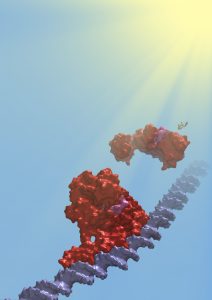
The Drennan lab has a long history of studying cobalamin and its role as an enzyme cofactor (see Publications on 5,6-lysine aminomutase, isobutyryl-CoA mutase, the corrinoid iron-sulfur protein, and epoxyqueuosine reductase (QueG), and also of studying metal-dependent transcription factors (see Publications on nickel-dependent transcription factor NikR). More recently, the Drennan lab has combined their interest in cobalamin chemistry with their interest in metalloprotein transcription factors through the study of transcription factor CarH.
In a newly discovered mode of light-dependent gene regulation, CarH-type transcription factors sense light using a derivative of vitamin B12, adenosylcobalamin. Although adenosylcobalamin is a cofactor best-known in radical reactions, here it is repurposed to function as a light sensor. The Drennan lab (in collaboration with the research groups of Padmanabhan and Elías-Arnanz) determined crystal structures of CarH in all three major functional states, visualizing how adenosylcobalamin-bound CarH assembles into a tetramer in the dark, how this tetramer represses transcription, and how light exposure induces a dramatic conformational change that breaks apart the tetramer to restore transcription. These results provide fundamental insight into a new mode of light-dependent gene regulation.
Incredibly, CarH has somehow altered adenosylcobalamin’s reactivity such that the light-induced cobalt-carbon bond cleavage of the cofactor does not produce the expected radical species. This alternation safeguards the use of adenosylcobalamin as a light sensor. Moving forward, the Drennan lab and their collaborators are interested in understanding the molecular mechanism responsible for this ‘safeguard,’ among a number of other outstanding questions (see Annual Review for additional information).
Press
MIT News September 28, 2015, Crystallography News, and Proteomics News: “A Natural Light Switch” by Peter Dizikes.
C&EN: “Vitamin B-12 Expands its Regulatory Role” by Stephen K. Ritter, October 5, 2015.
Cell (2015):“Seeing the Light through Borrowed Lenses” by Mirna Kvajo vol. 163, 1295.
Angewandte Chemie (2016): “Coenzyme B12 Repurposed for Photoregulation of Gene Expression” by Karl Gruber and Bernhard Kraütler vol. 55, 5638-5640.
Publications (*Corresponding authors)
Jost, M., Fernández-Zapata, J., Polanco, M.C., Ortiz-Guerrero, J.M., Chen, P.Y.-T., Kang, G., Padmanabhan*. S., Elías-Arnanz*, M., and Drennan*, C.L. (2015) Structural Basis for Gene Regulation by a B12-Dependent Photoreceptor, Nature 526, 536-541. PMCID: PMC4634937
Jost, M., Simpson, J.H., and Drennan*, C.L. (2015) The Transcription Factor CarH Safeguards Use of Adenosylcobalamin as a Light Sensor by Altering the Photolysis Products, Biochemistry 54, 3231-3234. PMCID: PMC4455981
Review Articles
Padmanabhan*, S., Jost*, M., Drennan*, C.L., and Elias-Arnanz*, M. (2017) A New Facet of Vitamin B12: Gene Regulation by Cobalamin-Based Photoreceptors, Ann. Rev. Biochem. 86, 485-514. PMC Exempt – Invited Review. DOI: 10.1146/annurev-biochem-061516-044500